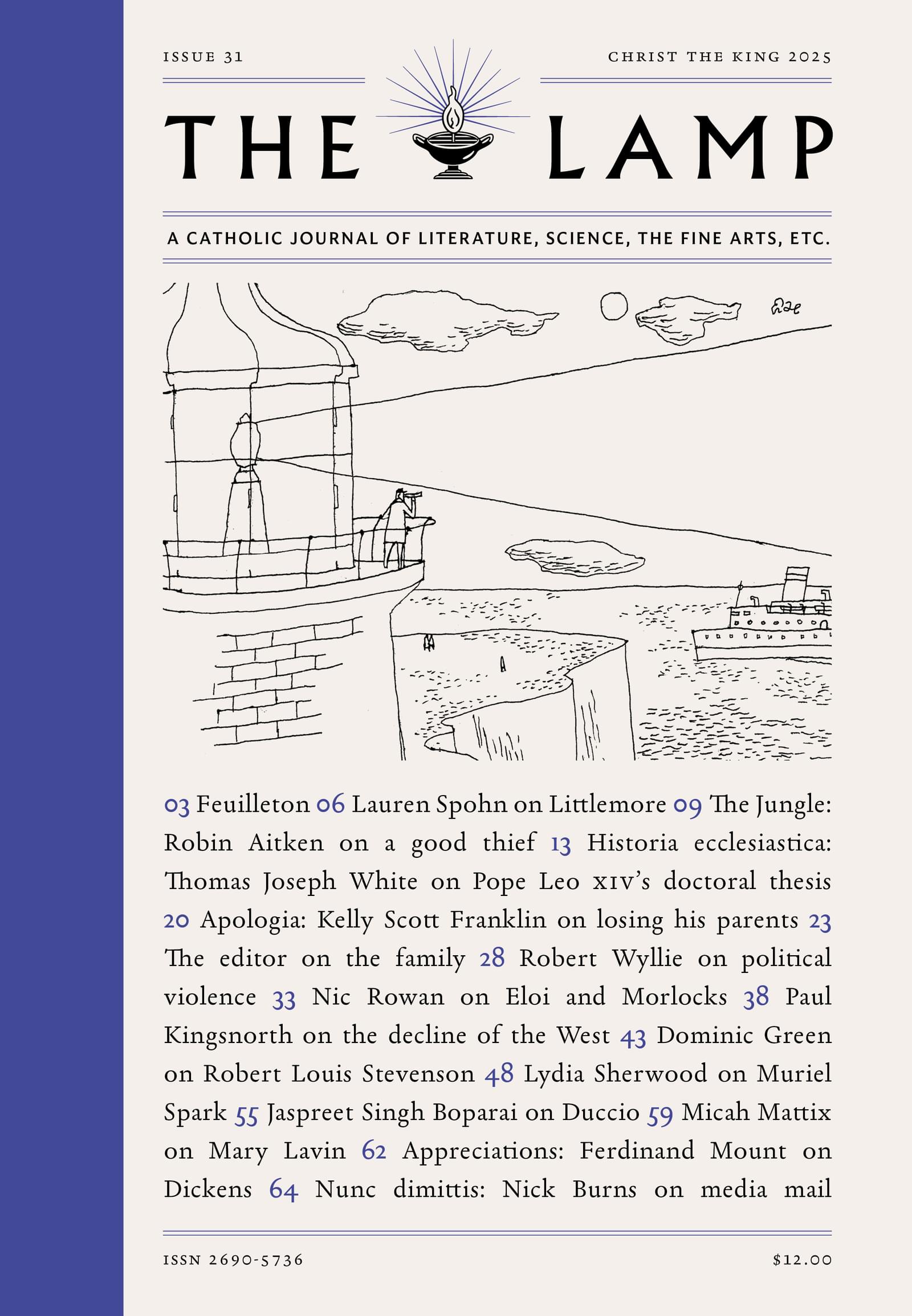At-One-Ment
Sitting down to write this article closer to the generous deadline than I first imagined, I was delighted to learn that The Lamp shares a name with the long-defunct publication of the Society of the Atonement, founded in the Episcopal Church by the Reverend Paul Wattson in 1898. From its origins, the Society of the Atonement had a mission to promote the visible unity of Christians. The modern-day Week of Prayer for Christian Unity was founded by Wattson and his fellows as an octave of prayer, quite intentionally located between the old feast of the Confession of Saint Peter (January 18) and the Conversion of Saint Paul (January 25). The Society and its prayer established a definitely Romeward direction of travel, and so it was only logical that Wattson and his community were received into the full communion of the Catholic Church in 1909.
The story of the Society of the Atonement and its journey to the Catholic Church is one of countless tales of groups of Anglicans becoming Catholic. Some of these ramshackle outfits achieved their goal admirably, whilst others achieved it only in part, and others still languished and failed. But the prevailing narrative in formal ecumenical circles has for many years been uniform in condemning them all as eccentrics, embarrassments even, who obstruct the real work of ecumenism. One ecclesiastical historian described their endeavors as “the fantasy of reunion.” I would like to make the case that the truth is, in fact, rather more nuanced.
For the past sixty years or so the ecumenical movement has approached the reunion of Christians with what we might call a “church to church” model: the restoration of full, visible communion between the historic bodies of Christians, East and West. It has rightly seen the divisions between Christians as a scandal to the proclamation of the Gospel, and justly sought to bind up the wounds that mar the Bride of Christ by bringing about a new kind of consensus between the Christian communities. A fruit—and cause—of these efforts has been the various formal ecumenical dialogues intended to identify discordant doctrines, to discuss them, and to discover positions of agreement, which in turn lead to greater unity.
The dialogue between Catholics and Anglicans has been one of the most visible. It began around the time of the Second Vatican Council, intensified during and immediately after it, and took on an unusually high level of publicity in the 1970s and ’80s, not least with visit of John Paul II to England in 1982 and the published work of the Anglican-Roman Catholic International Commission, often known simply as A.R.C.IC.
Anglicanism entered this conversation from a rather privileged position. The council attributed to Canterbury a special place amongst the ecclesial communities of the sixteenth century because so many of her traditions, rejected by continental Protestants, are of obviously Catholic origin. Unitatis redintegratio even spoke of these Catholic institutions which “in part continue to exist” within Anglicanism, despite separation from Rome.
It likely had in mind a threefold ministry, ecclesiastical law, dioceses, parishes, and cathedrals, and formal liturgical rites, the presence of which constitute a distinctive Anglican polity. On the one hand, Anglicanism distances itself from Calvinism’s outright rejection of the Church visible. On the other hand, by its separation from Rome, it necessarily rejects any claim of uniqueness on the part of the Catholic Church. From this arose the so-called branch theory, which allows Anglicans to claim to be a visible manifestation of the universal Church. As the Declaration of Assent puts it: “The Church of England is part of the One, Holy, Catholic and Apostolic Church.”
These external institutions, still visible to some extent in Anglicanism today, have often been deployed by its apologists as proofs in claims of apostolic and Catholic authority, in contradiction once more to Roman claims, and also in distinguishing Anglicans from European Protestants, as well Presbyterians and Puritans. Many Anglicans to this day dislike being called “Protestant” for that reason. And the texts of the seventeenth-century Anglican divines are replete with what to the Catholic ear at first sound like completely unobjectionable ideas in this regard. It is only by examining the ecclesiology that underpins these ideas that we come, by Catholic standards, to see their fundamental limitations.
The writings of Richard Hooker are a case in point. Hooker understood ordered liturgical worship to be a necessary part of the Christian religion and wrote of it in the splendid, richly sacramental language that would have made Calvinists wince. Such worship, he wrote, is “the Splendor and outward Dignity of our Religion, and are forcible Witnesses of ancient Truth; are likewise Provocations to the Exercise of all Piety, and shadows of our endless Felicity in Heaven.” Whether such expressions are the vestiges of genuine Catholic feeling or the mere political appropriation of Catholic ideas (or both at once) is a matter that can be debated. Regardless, it can be said that the survival of such views within the Church of England allowed its adherents to develop them and to make them into something coherent enough to be revived in the nineteenth century.
This was the task of the Oxford Movement, the Tractarians, and their inheritors in the Anglo-Catholic revival of the early twentieth century. Pusey, Keble, Newman, and their followers sought to revive Catholic principles in the Church of England. They did this in the hope of promoting their understanding of the Anglican project, and after Newman’s conversion, some made the case for corporate reunion with Rome. These efforts led not only to a rediscovery of Catholic ideas among Anglicans, but to a fervent desire to see a convergence not just of opinions and attitudes, but of structures.
During the next century, the Anglican Communion would depart substantially from what had once been considered the settled answers to basic questions of the Catholic religion. The ordination of women and an equivocal understanding of same-sex unions not only eroded the Catholic sediment upon which the bedrock of Anglicanism had rested; it also effaced relations with Rome. In a recent interview, Father Michael Nazir-Ali, the former Anglican bishop of Rochester and a member of A.R.C.I.C. recently ordained for the Ordinariate, said that these developments had undermined the ecumenical agreements made since the Second Vatican Council. Walter Kasper has gone further, describing the ordination of women as bishops as “a turning away from the common position of all churches of the first millennium.” The ecclesial body that had once been perhaps the closest to Rome on many questions is now further from rapprochement than at any time since the sixteenth century, and the ecumenical springtime that was in the air after the council has given way to winter. What had formerly been the ultimate goal of Anglican-Roman Catholic dialogue—the restoration of full and visible ecclesial communion—as well as the level and seriousness of what can be pursued by such exchanges, is fundamentally and forever changed.
Cardinal Kasper made his rather robust point at the Lambeth Conference in 2008, on the eve of the Church of England’s decision to admit women to episcopal ministry. He was invited to speak by Rowan Williams, then the Archbishop of Canterbury. He concluded his address by recalling precisely the Catholic institutes and traditions found within Anglicanism to which, some fifty years earlier, the council had itself alluded:
Anyone who has ever seen the great and wonderful Anglican cathedrals and churches the world over, who has visited the old and famous colleges in Oxford and Cambridge, who has attended marvelous Evensongs and heard the beauty and eloquence of Anglican prayers, who has read the fine scholarship of Anglican historians and theologians, who is attentive to the significant and long-standing contributions of Anglicans to the ecumenical movement, knows well that the Anglican tradition holds many treasures. These are, in the words of Lumen gentium, among those gifts which, “belonging to the Church of Christ, are forces impelling toward catholic unity.”
For many Anglicans, hope for ecclesial reunion continues despite these developments. The failure of institutional dialogue has in no small way led to a realization that the old way of doing ecumenism is irretrievably lost. Instead, those who remain faithful to the cause of reunion—the cause of the ecumenical movement and the council, no less—have been left to take up this task themselves. The original intentions of “church-to-church” dialogue has now been unofficially handed on to rather more amorphous groups within the various Christian communities, made up of those who remain faithful to the original roadmap and its definite direction of travel.
It was against this background that Pope Benedict XVI issued the apostolic constitution Anglicanorum coetibus in 2009, providing for personal ordinariates; structures equivalent to dioceses for the reconciliation of precisely such groups of Anglicans with the Apostolic See. More than just receiving such groups, Anglicanorum coetibus went further than anyone had predicted in retrieving also their patrimony; the riches of the Anglican tradition which were not only Unitatis redintegratio’s “Catholic traditions and institutions” but also Lumen gentium’s “forces impelling toward Catholic unity.”
The working out of what this Anglican patrimony is and is not has now been going on for a decade and will need to continue for many more. Pope Benedict saw it as a triptych: liturgical, spiritual, and pastoral. For its constitutive elements to be identified demands the passage of time as former-Anglicans-turned-Catholic settle into their new ecclesial home and come to see for themselves, and have others see in them, what makes them distinctive. But at least some of the more tangible of its elements can be ascertained more readily. The most significant is undoubtedly the Anglican liturgical heritage, which the Holy See inherited with alacrity in a set of liturgical books known as Divine Worship. Rites for baptism, marriage, and funerals were approved in 2012, a Missal in 2015, rites for the sick and dying in 2020, and more recently still the Divine Office has been published.
The Office is perhaps the best known and loved form of Anglican worship. Cardinal Kasper’s lauding of Evensong as “marvelous” is neither unusual nor unique. For Louis Bouyer it was “not only one of the most impressive, but also one of the purest forms of Christian common prayer to be found anywhere in the world.” Evensong in particular, still broadcast weekly on the B.B.C., continues to be a cultural reference point for a diverse crowd. Christopher Hitchens frequented it; Roger Scruton played the organ for it. Now, with the publication of Divine Worship: Daily Office, this uniquely English treasure of the Christian patrimony has been shared in a new way.
I started this essay referring to the Society of the Atonement. Father Paul, its founder, spoke of atonement as “at-one-ment,” the reconciliation through sacrifice of God and man. Death to self for the good of another is the essential pattern of the Christian life, informing everything from law to worship and ethical living. The fruit of such sacrifice, then, is not loss, but gain. The reception of these traditions within the fullness of Catholic communion neither depletes them nor dilutes the Church. For this reason, as Pope Benedict hoped, these elements of our now common patrimony can enrich us all, and with greater lamprophony proclaim Jesus Christ to the world.
Father James Bradley is a Priest of the Personal Ordinariate of Our Lady of Walsingham and assistant professor of canon law at The Catholic University of America in Washington, D.C. Divine Worship: Daily Office (Commonwealth Edition), containing the Office from the Anglican tradition newly approved for use in the Catholic Church, is available from The Catholic Truth Society of London at ctsbooks.org.




